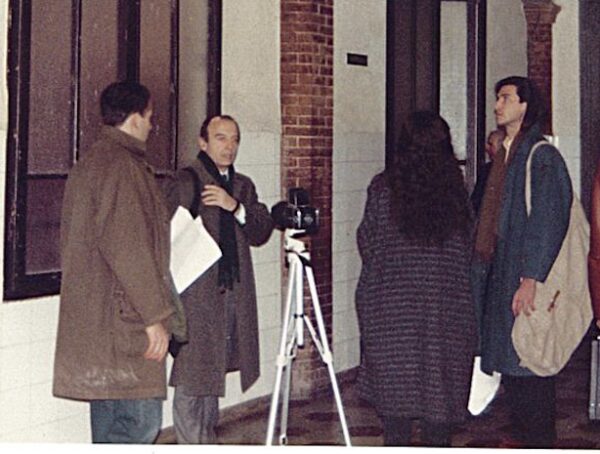How do we frame the work of female photographers? In 1865, British photographer Julia Margaret Cameron (1815-1879) received a review in The Photographic Journal that read, “Mrs Cameron exhibits her series of out-of-focus portraits of celebrities. We must give this lady credit for daring originality, but at the expense of all other photographic qualities.” The artist was criticised for her use of soft focus and untouched prints. Her illustrative images were considered amateurish. Over 100 years later, American photographer Francesca Woodman (1958-1981) took a similar approach to Cameron, using long-exposure shots to achieve a whimsical, ethereal image. In 1979, Woodman moved to New York to make a career in photography, sending off portfolios of her work to fashion photographers, but found that “her solicitations did not lead anywhere.” She was rejected for a grant from the National Endowment for the arts and in 1981, jumped from a loft window on the East Side of New York. Neither artist aimed for technical perfection in their printing, yet both creatives saw photography as a way of pushing the boundaries of image-making. Now, National Portrait Gallery displays a major retrospective, uniting over 160 rare vintage prints by both Cameron and Woodman. The exhibition moves away from biological emphasis, as has often been the focus of their work. Instead, the show is rooted in the photographers’ creative impulses and practices, acknowledging their significance at a time when women were marginal in the history of art.

The exhibition’s title, Portraits to Dream In, suggests that when seen side by side, both artists conjure up a dream state. The title comes from an observation made by Woodman that photographs could be “places for the viewer to dream in.” Her silver gelatin prints are embedded in curiosity. Many of her self-portraits appear blurred, contorted or obscured, caught mid-motion. The portraits stray from anything remotely conventional; they are fragile, ghostly and intimate. In the Polka Dot series, depicted above, a slow exposure renders Woodman as a dissolving figure. It feels intensely private, risky, and even, painful – as viewers are drawn to her bare feet stood on a panel of disintegrating floorboards. Elsewhere, we see Woodman’s Caryatid project, developed in the last year of her life. The artist experimented with large scale diazotype prints, including depictions of herself and others as caryatids – carved female figures which take the place of columns in ancient Greek temples. In an inkjet print turned near-violet, Woodman inserts her body into space and architecture. She positions her arms upwards, drawing attention to a wrinkled dress, tied around her chest to mimic the ridges of a column. It’s a work that is in equal parts performance and photography.


The gallery weaves Cameron and Woodman’s oeuvre beside each other, citing their references to gender, mythology and storytelling. Whilst Woodman tends towards self-portraiture, Cameron’ photographs reveal multiple different subjects. Included are many of the artist’s most famous and much loved portraits, including those of her niece and favourite model, Julia Jackson, a figure who would later be the mother to Bloomsbury artists Virginia Woolf and Vanessa Bell. Jackson poses with her hair let down, her eyes wide, in an unsentimental fashion. She solemnly looks off into the distance, unfettered by props or costumes. We’re also given a striking depiction of art model and original Alice in Wonderland inspiration, Alice Liddell, as the goddess Pomona. Against a dense thicket of leaves, Liddell poses in a white lace dress much like a wood nymph. Elsewhere, we see Cameron’s prominent portraits of Victorian men, including an iconic shot of John Frederick William Herschel, an English astronomer, mathematician and photographer who invented the blueprint. In a striking image titled The Astronomer, Cameron captures Herschel’s thick white hair, unkempt and tousled. The photographer favoured working with her intellectual heroes and wrote of the sitting, “When I have such men before my camera my whole soul has endeavoured to do its duty towards them. The photograph thus taken has been almost the embodiment of a prayer.”

The exhibition will also be the first to draw significant attention to Woodman’s portraits of men, as well as exploring the importance of her ongoing photographs of friends. It informs the final component of the exhibition “Men and Models & Muses.” Male models appear in the position of feminine-associated objects – cradling pomegranates or eggs. These are arresting, particularly in their softness and vulnerability, even more so when contrasted alongside Cameron’s more harshly rendered, high-contrast portraits of men such as Alfred Tennyson or Henry Taylor. Where Cameron writes that she wanted to record “the greatness of the inner as well as the features of the outer man,” to Woodman, this is something more to be blurred completely. Inner and outer are pulled together and diluted, made indistinct. The internal world makes its way to the fore, resulting in figures that feel not strictly like humans but more like souls. This sense of collapsing boundaries is furthered by an exhibition that collapses chronologies as viewers are transported back and forth between 19th and 20th centuries. It’s also supported by an extensive programme of eventsthat include lectures on the possibilities of photography as well as the importance of the female gaze. Portraits to Dream In feels fierce and uncompromising, as it gives audiences unrestricted access to the short bursts of time that both Cameron and Woodman composed in – where neither artists worked for more than 15 years. Curator Magdalene Keaney sums it up best, “Visitors [should] relish the physical experience of seeing such a large collection of prints that each artist made. They are subtle, intricate, and beguiling.”
Francesca Woodman and Julia Margaret Cameron: Portraits to Dream In | Until 16 June
Words: Chloe Elliott
Image Credits:
Untitled, 1979’, Francesca Woodman (Woodman Family Foundation/ DACS)
Polka Dots #5 by Francesca Woodman, 1976. Photograph: Courtesy Woodman Family Foundation/DACS
Julia Prinsep Stephen (nee Jackson, formerly Mrs Duckworth by Julia Margaret Cameron, 1867.
The Dream (Mary Hillier) by Julia Margaret Cameron, 1869. Wilson Centre for Photography.
These People Live in That Door, 1976077. Courtesy Woodman Family Foundation/DACS







